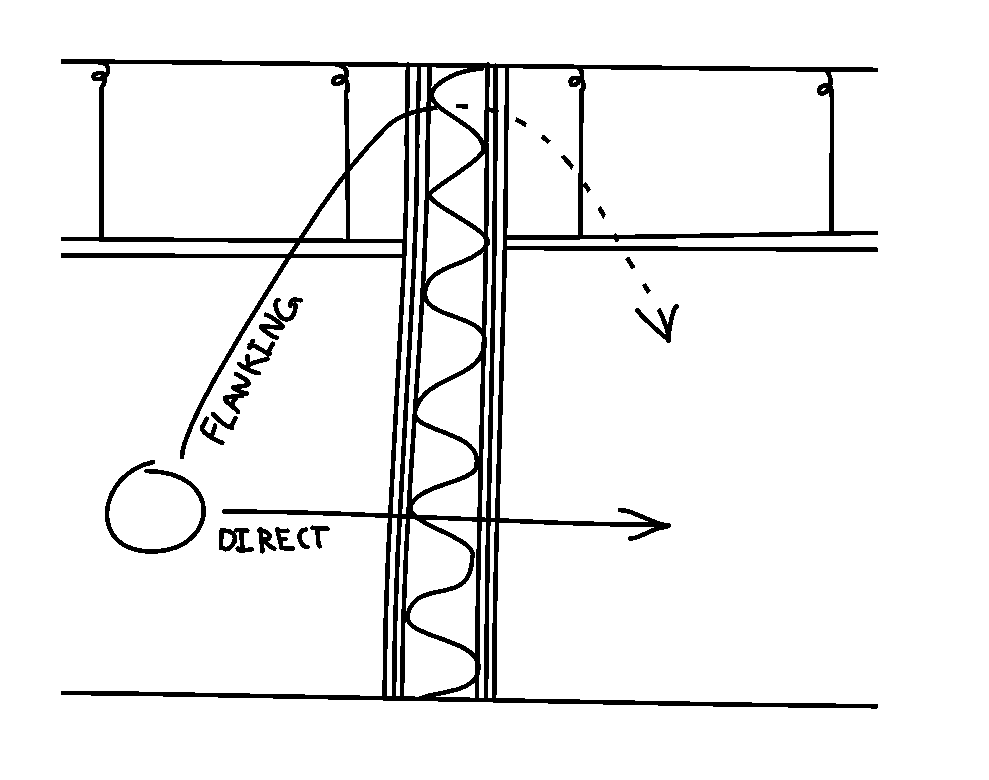Typical office noise problems
The Problem with flanking noise in office buildings.
Office acoustics can be more complex than they initially appear. One common challenge in office spaces is the phenomenon of “climbing sound” through suspended acoustic ceilings, which compromises the sound reduction between rooms. While suspended acoustic ceilings are designed to absorb and block sound, they may not always effectively prevent sound waves from traveling over separating walls and infiltrating adjacent rooms. This issue is often observed in office spaces where there was inadequate acoustic planning during the construction phase.
Flanking transmissions occur when sound energy travels through the air gap between the suspended acoustic ceiling and over the top of partition walls. This “climbing sound” path significantly reduces the effectiveness of the acoustic barrier, resulting in potential disturbances in neighboring spaces. It can lead to a lack of privacy, decreased concentration, and reduced productivity among employees.

A typical problem with the design of partitions in office buildings. The direct flanking path through the wall will provide optimal sound insulation, however the flanking path that goes through the suspended acoustic ceiling and over the wall, can be a cause for a noisy environment. Office buildings rarely have the same sound insulation requirements as living dwellings, and therefore measures and done to cut costs, which in turn, can cause these issues.
The Solution: catching the problem early in the design process
To address the problem of climbing sound and improve office acoustics, comprehensive strategies can be employed. Here are some solutions:
- Proper sealing and continuity: Ensuring that there is a proper seal and continuity between the suspended ceiling and the walls can help minimize the leakage path for sound. This involves paying attention to the installation details and using appropriate materials to close any gaps or openings that could allow sound to escape or enter neighboring spaces.
- Sound-blocking materials: Installing sound-blocking materials above the suspended acoustic ceiling can enhance sound insulation. These materials can be specifically designed to absorb and block sound, reducing the chances of sound waves climbing over the partition walls. By adding an additional layer of sound insulation, the transmission of sound can be significantly reduced.
- Higher partition walls: Constructing higher partition walls between rooms is the best way to help improve sound insulation. By increasing the height of the walls, the direct path for sound waves to climb over the partitions is interrupted, making it more difficult for sound to travel between rooms. Higher partitions create a physical barrier that prevents sound from easily bypassing the intended sound insulation.

Sometimes, the simple solution is catching the problem early on in the design process. Having a specialist look at the design and provide insight into the complications that might follow. To avoid unforseen and problematic sound flanking paths, a way is to have a continuity from the floor to the top ceiling (slab) to mitigate the flanking paths.
By implementing these strategies, a balanced and acoustically optimized office environment can be created. This is crucial for fostering concentration, productivity, and employee well-being. By minimizing disturbances and ensuring privacy, employees can work more effectively and comfortably, leading to a more productive and pleasant workplace.